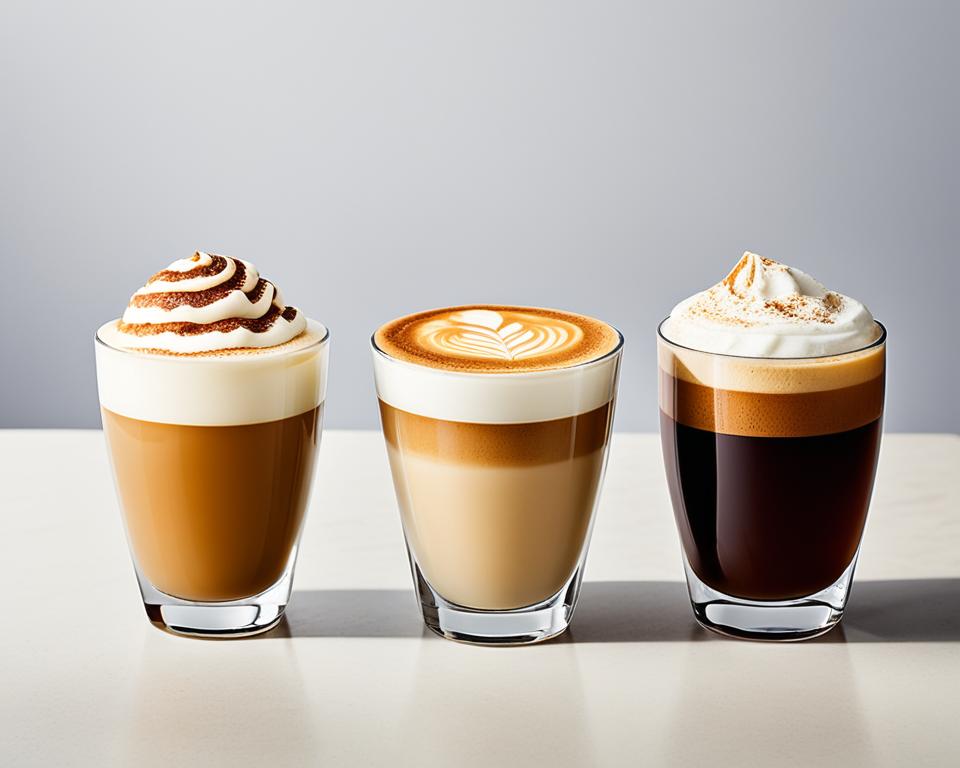Imagine the smell of freshly brewed espresso filling the air and the warmth of a cosy coffee shop wrapping around you. This scene is where I truly fell in love with coffee. The first time I was handed a cortado vs. cappuccino, I marvelled at its simplicity—equal parts espresso and steamed milk, a perfect balance of strong coffee flavour and creamy sweetness.
Fast forward to another day; I had my first cappuccino, and what a delight it was! The airy texture of frothy milk blending with espresso created an almost dessert-like feel, making each sip a soothing experience.
For coffee lovers, understanding the nuances of a cortado versus a cappuccino can elevate your coffee journey. These espresso drinks might appear similar but differ greatly in their proportions and textures.
A cortado, with its layer of steamed milk ‘cutting’ the espresso, offers a direct and robust taste. In contrast, a cappuccino takes you on a smooth ride with its milk-based froth mingling elegantly with the coffee, resulting in a light, airy texture.
Whether you prefer the boldness of a cortado or the delicate balance of a cappuccino, both of these milk-based coffees offer something unique.
Through this coffee comparison, I’ll guide you to distinguish their characteristics and qualities, helping you choose your next favourite cup. So, shall we dive in and explore these espresso drinks more deeply?
Introduction to Cortado and Cappuccino
For coffee lovers, appreciating the differences between espresso-based beverages like cortados and cappuccinos can enrich their coffee culture experience.
These drinks are classic barista favourites rooted deeply in European traditions. Cortado and cappuccino both provide unique tastes and textures, making them staples for anyone exploring coffee culture.

Understanding the nuances of these beverages is key to enhancing personal enjoyment and social connections over coffee. With the cortado offering a stronger coffee flavour and the cappuccino delivering a frothy experience, there’s something for every coffee lover.
Whether you prefer sipping on a balanced cortado or indulging in the light, airy feel of a cappuccino, knowing what sets them apart is insightful for making the best choice for your palate.
Let’s set the stage for a deeper look into how these espresso-based beverages have shaped the coffee culture. By delving into their history, preparation methods, and variations, we’ll discover what makes cortados and cappuccinos enduring barista favourites.
Stay tuned to learn more about these exquisite coffee drinks and enhance your daily coffee rituals.
Origin and History
Embarking on a journey through the origins and history of coffee can be fascinating. Both the Spanish cortado and the Italian cappuccino have unique stories that weave into the fabric of their respective cultures, offering insights into their coffee roots and espresso traditions.
History of the Cortado
The Spanish cortado derives its name from the Spanish word “cortar,” meaning “to cut.” This makes sense, as the small amount of milk is used to soften, or cut, the sharp edge of the espresso, resulting in a smooth, balanced drink.
Originating in the bustling cafes of Spain, the cortado quickly became a favourite among locals for its strong yet mellow flavour profile.

History of the Cappuccino
On the other hand, the Italian cappuccino has its roots in Italy. It’s traditionally consumed at breakfast and gets its name from the Capuchin monks’ robes, which are a similar brownish colour.
The cappuccino’s rise to fame can be traced back to the early 20th century. A blend of espresso, steamed milk, and froth, it became a morning staple for many Italians.
By learning about these drinks’ coffee roots and the different espresso traditions, we can truly appreciate the cultural significance behind each beverage.
Understanding this history helps us to enjoy every sip with a deeper connection to its origin.
Ingredients and preparation
Preparing a cortado or a cappuccino requires some specific techniques to get the perfect cup. Understanding the nuances can elevate your coffee game at home or help you appreciate what your barista does.
Cortado Ingredients and Preparation
When it comes to cortado preparation, simplicity is key. This delightful drink typically uses a 1:1 ratio of espresso to steamed milk. Start with a high-quality espresso shot.
This is crucial because the espresso technique plays a big role in the flavour profile of your cortado.
Next, the milk texture is where you’ll need to be precise. Steam the milk just enough to create a thin layer of microfoam. It should be velvety but not overly frothy.
Pour the milk gently over the espresso, ensuring an even mix.
Cappuccino Ingredients and Preparation
The cappuccino craft involves a bit more complexity with its 1:1:1 ratio of espresso, steamed milk, and froth. Begin with that perfect espresso shot—it sets the foundation.
The milk texturing for a cappuccino is where the magic happens. Steam the milk to achieve a luxurious, airy foam topping.
To assemble, pour the steamed milk into the espresso, holding back the foam with a spoon. Then, gently top off with the foam to create an inviting, layered effect.
Traditionalists might stick to this method, but modern twists might include alternative milk choices or an extra espresso shot for a stronger kick.
Flavor and texture
When diving into the world of coffee flavours and textures, each espresso-based beverage offers a unique sensory experience. For instance, a cortado and a cappuccino differ significantly in their taste profiles and mouthfeel, making for an intriguing taste comparison.
Cortado’s Flavor Profile
The cortado’s flavour profile is a true delight for those who enjoy a bold espresso. Its equal parts espresso and steamed milk allow the coffee’s rich nuances to shine through, with a mild smoothness that tempers the espresso’s intensity.
This balance allows coffee lovers to truly discern the intricate flavours of the coffee beans.
Cappuccino’s Flavor Profile
On the flip side, a cappuccino offers an entirely different experience. While it still delivers a bold espresso foundation, the added layer of velvety foam creates a creamy, airy texture.
The froth provides a sweetness that beautifully harmonises with the coffee, making each sip a delightful blend of flavours.
In the end, whether you favour the strong, direct taste of a cortado or the light and fluffy cappuccino, there’s no wrong choice. Your preference will shape how you enjoy these distinct coffee textures.
What Are the Key Differences Between Cortado and Cappuccino?
When comparing cortado and cappuccino, the main differences lie in their milk textures and ratios. A cortado features equal parts espresso and steamed milk, resulting in a balanced flavor. In contrast, a cappuccino boasts a thicker layer of foam. For an in-depth look at coffee drinks, read “cappuccino versus latte explained.
Caffeine Content
When examining coffee strength, it’s vital to understand the caffeine levels in both cortado and cappuccino. Typically, both drinks start with a single espresso shot, meaning they have comparable caffeine content.
If you’re keeping track of your daily caffeine intake, both options fit well into a balanced consumption strategy. Each espresso shot contains about 63 milligrammes of caffeine.
Having a few cups during the day can energise you without exceeding recommended caffeine levels.
Often, people ask me if they can add more espresso shots to their drinks. Absolutely! Adding extra shots enhances the coffee’s strength and introduces a bolder flavour.
This customisation allows you to tailor the caffeine levels according to your personal preference, providing more control over your daily caffeine intake.
Understanding how caffeine affects your body is crucial. It can help you make informed decisions about whether a single shot in a cortado or cappuccino suits your needs or if extra shots are necessary to manage your energy levels throughout the day.
What’s your preference? Do you stick with a single shot or go for that extra boost?
FAQ
What’s the difference between a cortado and a cappuccino?
A cortado and a cappuccino differ in their espresso-to-milk proportions and textures. A cortado features equal parts espresso and steamed milk, giving it a strong coffee flavour with a creamy touch. In contrast, a cappuccino has a mix of espresso, steamed milk, and frothy milk, providing a lighter, airier texture and a balanced taste between milk and coffee.
Where do cortado and cappuccino originate from?
The cortado originated in Spain, and its name means “cut,” referring to how the milk cuts the espresso’s intensity. The cappuccino comes from Italy, is traditionally enjoyed at breakfast, and is named after the distinctive colour of Capuchin monks’ robes.
What are the primary ingredients for a cortado vs. a cappuccino?
A cortado consists of a 1:1 ratio of espresso to steamed milk. On the other hand, a cappuccino is composed of equal parts espresso, steamed milk, and frothy milk. The quality of the espresso and the technique used to texture the milk are crucial for both drinks.
How do the flavours and textures of cortado and cappuccino compare?
A cortado offers a more direct espresso taste with a mild smoothness, allowing the nuances of the coffee beans to shine through. In contrast, cappuccinos have a creamy, airy texture with a sweetness that brings harmony between the foam and coffee. Your personal taste preferences will play a significant role in determining which flavour profile you enjoy most.
What is the caffeine content of a cortado vs. a cappuccino?
Both cortado and cappuccino typically start with a single shot of espresso, meaning they have similar caffeine content. However, you can add extra shots if you prefer a stronger drink, which will increase both the caffeine level and the intensity of the flavors.
Are there any popular variations of cortado vs. cappuccino?
Yes, there are many creative variations. For cortados, you might encounter the Gibraltar or the flat white, which provide delightful twists on the classic drink. For cappuccinos, flavoured versions (like vanilla or hazelnut) and iced cappuccinos are popular. Regional preferences and seasonal ingredients often inspire these unique takes on traditional beverages.




